Bees, Wasps & Ants
Bees, Wasps & Ants form a major part of the order Hymenoptera - a word that means membranous wing. Bees and wasps often generate fear in many people, because of a reputation for stinging. However, the overwhelming majority of species are not agressive at all and many don't even have stings. Unfortunately, the reputation of a small number of social wasp species has given the whole group a bad name. The order Hymenoptera also includes ants and sawflies; most begin life as grub-like larvae, tended by the adults, but sawfly larvae feed on leaves and resemble the caterpillars of butterflies and moths. Many species are either social and live in complex colonies under the control of a single 'queen'or are solitary but live in loose colonies - each has it's own breeding chamber but they all benefit from safety in numbers. Many species are parasitic on other insects, often parasitizing other species of bee and wasp. Egg laying is carried out through an ovipositor as the tip of the abdomen, and it is this structure that has evolved in some species to become a sting. Thus, it is only the non-fertile females of colonial, social species that are able to sting, since fertile females (queens in social species) still need to lay eggs.
The distinction between bees and wasps is a little artificial and difficult to define but, in general, wasps tend to have an obvious and often very thin 'waist' between the abdomen and the thorax, while bees have no such narrow waist - though this distinction does not always hold true.Despite the bad reputation of the group, caused by the stinging abilities of just a few, social species, bees and wasps are valuable insects in the environment; many species are among our most important plant pollinators, while others are voracious predators of garden pests.
At this stage, be sure to read the text next to the pictures and go for the best match, as the next stage will help you get to the exact species.
(For a list of all bee, wasp and ant species on the site, click here)
Use the photos below to narrow your search to a group of bees, wasps or ants, then click on the picture to go to the next stage.
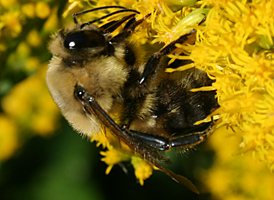 |
Bumble Bees & Carpenter Bees
Heavy-bodied, chunky insects with no waist and usually covered in dense hairs. Most bumble bees are social species, making small nests in holes in the ground. Some species (known as cuckoo bees) are less hairy and don't construct their own nest, but parasitize other species. These species are very important pollinators. Carpenter bees resemble bumble bees closely, but usually have dark, smoky colors on the wings. Carpenter bees make their homes semi-socially in wooden structures or dead trees.
|
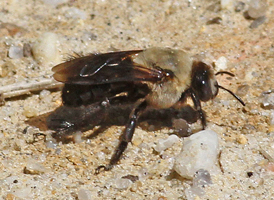 |
Digger Bees
Smaller-bodied than bumble bees but otherwise often very similar to them. These bees are quite common as a group, but some species are rather specialized in their choice of breeding sites and food choice and thus can often be rather local in occurence. Species often nest in small burrows dug into sandy ground.
|
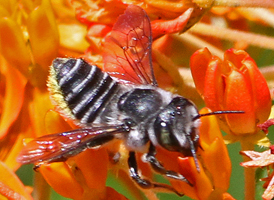 |
Leafcutter & Mason Bees
Smaller to medium sized bees which are largely solitary and mostly dark in color, often with narrow, pale bands on the abdomen. Most often seen nectaring at flowers or visiting their nests which tend to be placed in holes in woodwork, masonry or in hollow plant stems.
|
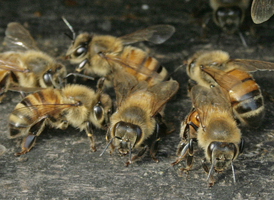 |
Honey Bees
Smaller-bodied than bumble bees and with orange and brown being the main colors. Abundant bees found throughout the summer on a wide variety of flowering plants, from where they collect pollen to make honey as food for their young. Social insects that can form large colonies with thousands of members. Introduced from Europe and kept in hives commercially to provide honey.
|
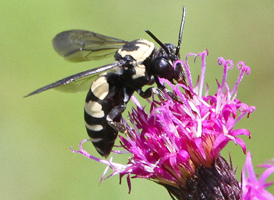 |
Triepeolus Cuckoo Bees
Small to medium-sized bees that get their English name from the habit of parasitizing the nests or broods of other bee species. The narrow abdominal bands and lack of hairs give these bees a rather wasp-like look.
|
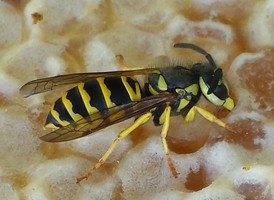 |
Social Wasps
A variable group, that may be largely black, yellow or chestnut in color. Like honey bees, these species form large colonies so they are often seen gathered together at a food source. These are the wasps most likely to be seen at over ripe fruit in the fall. WARNING: These insects sting readily and should be approached with caution.
|
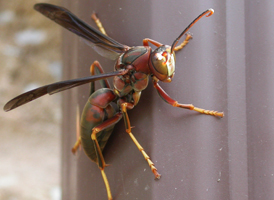 |
Paper Wasps
Medium to large, common and widespread wasps. Paper wasps are inquisitive but largely harmless to humans. They are perhaps most readily identified by their slender bodies and by their long legs, which dangle below the body in flight. Most species are a mixture of yellow and rust-brown.
|
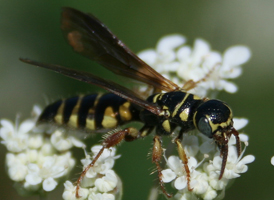 |
Thynnid Wasps
Small, relatively slender wasps that are common and active around flowers during the summer. Most species are narrowly banded in black and yellow. Males and females can be quite different in appearance.
|
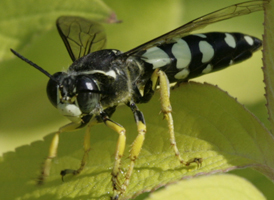 |
Sand Wasps
Small to medium wasps that are mostly seen solitarily hunting around open fields or tending burrows made in the ground in sandy soil. Typically yellow-and-black and white-and-black with a short, easily-missed waist.
|
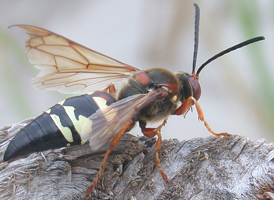 |
Sand Wasps
Large and industrious wasps that seem always to be busy and on the move. Intricately marked in chestnut, black and cream.
|
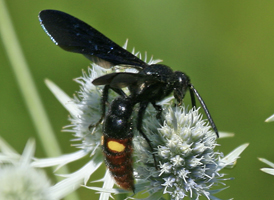 |
Scoliid Wasps
Chunky, medium-sized to small wasps. Most species are colorful, covered in dense, short hairs, and have dark wings.
|
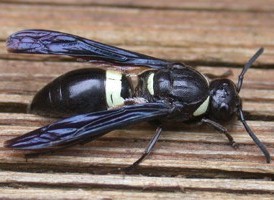 |
Mason & Potter Wasps
Mostly black wasps with creamy or yellow markings. Solitary species that are most often seen feeding at nectar-bearing flowers.
|
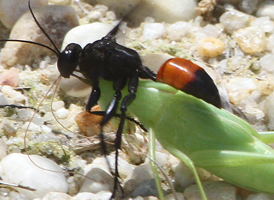 |
Solitary Wasps
Large and industrious wasps that seem always to be busy and on the move. The twitchy, hyperactive behavior can be quite distinctive once learned. May be black, black and red/orange or black and yellow.
|
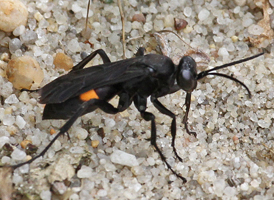 |
Spider Wasps
Long-legged, medium to large insects that are usually mostly black or rusty-brown. These are highly active insects, most often seen running over the ground with rapidly twitching wings and antennae.
|
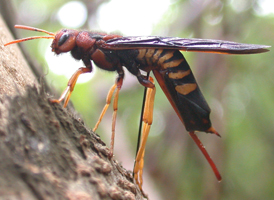 |
Horntails
Impressive and imposing, large wasps with formidable-looking 'stings' which are actually the ovipositors of the females. May grow up to two inches in length.
|
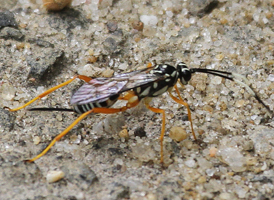 |
Ichneumon Wasps
Medium to large insects that are usually colored with black or black-and-white, or rusty-brown. Most species are slender and elongate and most constantly twitch their antennae. Legs are often long and held dangling in flight. Females of many species have very long ovipositors which can look like intimidating stings - but are harmless. Some smaller species are capable of stinging.
|
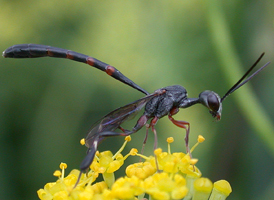 |
Carrot Wasps
Medium-sized wasps which are immediately eye-catching in their appearance, due to the peculiar, elongate abdomen which is often held high in the air. Females have remarkably long ovipositors at the far end of the abdomen. Note also the long 'neck' between the head and thorax Most often seen visiting the flowers of the carrot family.
|
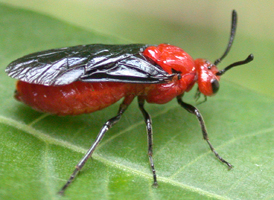 |
Argid Sawflies
Small, stingless wasps, usually measuring around 8-15mm. Sawflies are very different to most other bees and wasps in having caterpillar-like larvae, many of which feed socially in tight clusters. For many of these, it is possible to tell sawflies from Lepidopteran (butterflies & moths) larvae by tapping the branch or leaf that they are on - sawflies will raise up into an 'S'-shaped curve - remember S for Sawfly. Argid Sawfly adults are often bright red or orange.Unlike other hymenopterans, sawflies tend not to have an obvious waist.
|
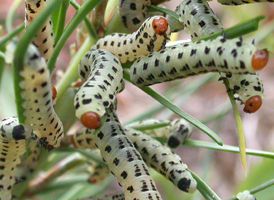 |
Conifer Sawflies
Small to medium-sized, stingless wasps. Sawflies are very different to most other bees and wasps in having caterpillar-like larvae, many of which feed socially in tight clusters. For many of these, it is possible to tell sawflies from Lepidopteran (butterflies & moths) larvae by tapping the branch or leaf that they are on - sawflies will raise up into an 'S'-shaped curve - remember S for Sawfly. Unlike other hymenopterans, sawflies tend not to have an obvious waist.
|
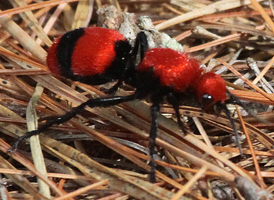 |
Velvet Ants
A group of highly active insects, the wingless females of which run tirelessly across the ground. Though these insects look like ants, they differ most obviously in being covered in dense hairs and are, in fact, more closely related to wasps.
|